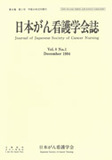Japanese
English
- 販売していません
- Abstract 文献概要
- 参考文献 Reference
要約
神奈川県立がんセンターにおいて,ターミナル期のがん患者に対する「在宅ケア」導入の可能性と問題点を把握する目的のために,退院時に継続看護依頼がなされたがん患者57人の資料を解析した.継続看護が依頼された患者は性,年齢階級,腫瘍部位に関して,全退院患者と大きな相違はなかった.結果は以下のようであった.
1.ADLに関して,排泄,入浴,更衣,移動において全面介助か必要であった患者は30〜50%であった.
2.食事に関しては,全面介助が必要と判断された患者は約10%と低かった.
3.患者のうち,17.5%は独居者であった.
4.継続看護の依頼内容では,介護者不在や風呂,階段,トイレなどの構造上の問題による依頼がもっとも多かった(89.5%).
5.医療援助としては,バルン・ストマ・IVH・在宅酸素の管理がそれぞれ5〜10%であった.
6.Coxの比例ハザードモデルにより予後因子として抽出された項目は,高血圧歴なし,転移あり,手術歴なし,疼痛コントロールあり,IVH管理あり,在宅酸素管理あり,高年齢がいずれも死亡との関連性が強かった
以上の結果から,がん患者の「在宅ケア」には介護者の確保や自宅構造の改善の必要性とともに,臨床の医師や看護婦の参加の必要性が考えられた.とくに,がん医療の専門施設としては,臨床の医師・看護婦の訪問が不可欠であると思われる.今後は,がん患者に対する「在宅ケア」の有効性を評価するための指標やがん患者,介護者のQOL評価の指標の開発が必要であり,がんの部位別に「在宅ケア」の手法を開発する必要があろう.
Abstract
This article presented the findings of survey carried out to elucidate the problems of introducing a home-based care system at Kanagawa Cancer Center. The study population consisted of 57 patients with cancer who received continued nursing at home between April 1991 and March 1993. There was no differences between the patients and the total number of discharged patients in regard to age and cancer site.
The findings were :(1)The bad activities of daily life in the surveyed patients were 30 - 50% for excretion, bathing, clothing, and moving.(2)Ninety percent of the patients were able to eat unaided.(3)The percentage of patients who were single was 17.5 %. (4)Apart from medical care, the aid most frequently desired by the patient was related the absence of attendant at home and the structure of their homes(toilet, stairs, bathroom, etc).(5)For medical care aid, the need for stoma supervision, balloon catheter supervision, IVH supervision, or oxygen supervision at home was expressed by 5- 10% of the patients.(6)The prognostic factors determined by Cox's proportional hazard model for the patients were metastasis, history of hypertension, history of operation, history of pain supervision, history of IVH supervision, history of oxygen requirement at home and old age.
On the basis of these findings, the conclusion of this survey was that the participation of physicians and nurses employed by the clinic is indispensable for introduction of a home -based care system operated by a hospital that specializes in cancer treatment. It is necessary to develop guidelines that take into account factors other than prognosis for evaluation of the efficacy of the home care and for evaluation of the quality of life of the patients receiving the care.
Copyright © 1994, Japanese Society of Cancer Nursing All rights reserved.


